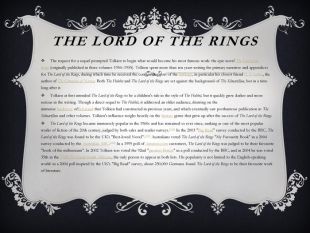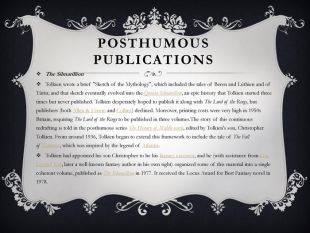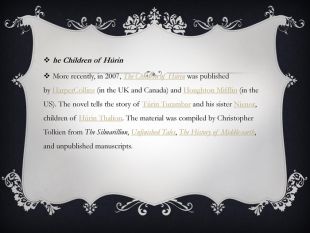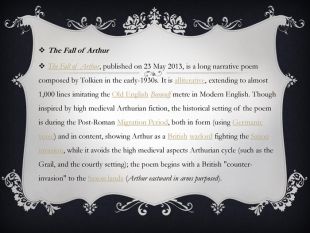Презентация :"J. R. R. Tolkien" часть 2
Презентация :"J. R. R. Tolkien" часть 2

![British adventure stories. One of the greatest influences on Tolkien was the Arts and Crafts polymath William Morris. Tolkien wished to imitate Morris's prose and poetry romances, from which he took hints for the names of features such as the Dead Marshes in The Lord of the Rings[123]and Mirkwood, along with some general aspects of approach. Edward Wyke-Smith's The Marvellous Land of Snergs, with its](/uploads/files/518/718/687_images/2.jpg)
![European mythology. Tolkien was inspired by early Germanic, especially Old English, literature, poetry, and mythology, which were his chosen and much-loved areas of expertise. These sources of inspiration included Old English literature such as Beowulf, Norse sagas such as the. Volsunga saga and the Hervarar saga,[136] the Poetic Edda, the Prose Edda, the Nibelungenlied, and numerous other culturally related works.[137] Despite the similarities of his work to the Volsunga saga and the Nibelungenlied, which were the basis for Richard Wagner's opera cycle Der Ring des Nibelungen, Tolkien dismissed critics' direct comparisons to Wagner, telling his publisher, European mythology. Tolkien was inspired by early Germanic, especially Old English, literature, poetry, and mythology, which were his chosen and much-loved areas of expertise. These sources of inspiration included Old English literature such as Beowulf, Norse sagas such as the. Volsunga saga and the Hervarar saga,[136] the Poetic Edda, the Prose Edda, the Nibelungenlied, and numerous other culturally related works.[137] Despite the similarities of his work to the Volsunga saga and the Nibelungenlied, which were the basis for Richard Wagner's opera cycle Der Ring des Nibelungen, Tolkien dismissed critics' direct comparisons to Wagner, telling his publisher,](/uploads/files/518/718/687_images/3.jpg)
![Tolkien also acknowledged several non-Germanic influences or sources for some of his stories and ideas. Sophocles' play Oedipus the King he cited as inspiring elements of The Silmarillion and The Children of Húrin. In addition, Tolkien first read William Forsell Kirby's translation of the Finnish national epic, the Kalevala, while attending King Edward's School. He described its character of Väinämöinen as one of his influences for Gandalf the Grey. The Kalevala's antihero Kullervo was further described as an inspiration for. Túrin Turambar.[142] Dimitra Fimi, Douglas A. Anderson, John Garth, and many other prominent Tolkien scholars believe that Tolkien also drew influence from a variety of Celtic (Irish, Scottish and Welsh) history and legends. However, after the Silmarillionmanuscript was rejected, in part for its Tolkien also acknowledged several non-Germanic influences or sources for some of his stories and ideas. Sophocles' play Oedipus the King he cited as inspiring elements of The Silmarillion and The Children of Húrin. In addition, Tolkien first read William Forsell Kirby's translation of the Finnish national epic, the Kalevala, while attending King Edward's School. He described its character of Väinämöinen as one of his influences for Gandalf the Grey. The Kalevala's antihero Kullervo was further described as an inspiration for. Túrin Turambar.[142] Dimitra Fimi, Douglas A. Anderson, John Garth, and many other prominent Tolkien scholars believe that Tolkien also drew influence from a variety of Celtic (Irish, Scottish and Welsh) history and legends. However, after the Silmarillionmanuscript was rejected, in part for its](/uploads/files/518/718/687_images/4.jpg)




![The Lord of the Rings. The request for a sequel prompted Tolkien to begin what would become his most famous work: the epic novel The Lord of the Rings (originally published in three volumes 1954–1955). Tolkien spent more than ten years writing the primary narrative and appendices for The Lord of the Rings, during which time he received the constant support of the Inklings, in particular his closest friend C. S. Lewis, the author of The Chronicles of Narnia. Both The Hobbit and The Lord of the Rings are set against the background of The Silmarillion, but in a time long after it. Tolkien at first intended The Lord of the Rings to be a children's tale in the style of The Hobbit, but it quickly grew darker and more serious in the writing. Though a direct sequel to The Hobbit, it addressed an older audience, drawing on the immense backstory of. Beleriand that Tolkien had constructed in previous years, and which eventually saw posthumous publication in The Silmarillion and other volumes. Tolkien's influence weighs heavily on the fantasy genre that grew up after the success of The Lord of the Rings. The Lord of the Rings became immensely popular in the 1960s and has remained so ever since, ranking as one of the most popular works of fiction of the 20th century, judged by both sales and reader surveys.[156] In the 2003 The Lord of the Rings. The request for a sequel prompted Tolkien to begin what would become his most famous work: the epic novel The Lord of the Rings (originally published in three volumes 1954–1955). Tolkien spent more than ten years writing the primary narrative and appendices for The Lord of the Rings, during which time he received the constant support of the Inklings, in particular his closest friend C. S. Lewis, the author of The Chronicles of Narnia. Both The Hobbit and The Lord of the Rings are set against the background of The Silmarillion, but in a time long after it. Tolkien at first intended The Lord of the Rings to be a children's tale in the style of The Hobbit, but it quickly grew darker and more serious in the writing. Though a direct sequel to The Hobbit, it addressed an older audience, drawing on the immense backstory of. Beleriand that Tolkien had constructed in previous years, and which eventually saw posthumous publication in The Silmarillion and other volumes. Tolkien's influence weighs heavily on the fantasy genre that grew up after the success of The Lord of the Rings. The Lord of the Rings became immensely popular in the 1960s and has remained so ever since, ranking as one of the most popular works of fiction of the 20th century, judged by both sales and reader surveys.[156] In the 2003](/uploads/files/518/718/687_images/9.jpg)






British adventure stories. One of the greatest influences on Tolkien was the Arts and Crafts polymath William Morris. Tolkien wished to imitate Morris's prose and poetry romances, from which he took hints for the names of features such as the Dead Marshes in The Lord of the Rings[123]and Mirkwood, along with some general aspects of approach. Edward Wyke-Smith's The Marvellous Land of Snergs, with its "table-high" title characters, strongly influenced the incidents, themes, and depiction of Bilbo's race in The Hobbit. Tolkien also cited H. Rider Haggard's novel She in a telephone interview: "I suppose as a boy She interested me as much as anything—like the Greek shard of Amyntas [Amenartas], which was the kind of machine by which everything got moving."A supposed facsimile of this potsherd appeared in Haggard's first edition, and the ancient inscription it bore, once translated, led the English characters to She's ancient kingdom. Critics have compared this device to the Testament of Isildur in The Lord of the Rings[127] and to Tolkien's efforts to produce as an illustration a realistic page from the Book of Mazarbul. Critics starting with Edwin Muir[129] have found resemblances between Haggard's romances and Tolkien's.[130][131][132]Tolkien wrote of being impressed as a boy by S. R. Crockett's historical novel The Black Douglas and of basing the Necromancer (Sauron) on its villain, Gilles de Retz. Incidents in both The Hobbit and The Lord of the Rings are similar in narrative and style to the novel,and its overall style and imagery have been suggested as an influence on Tolkien.
European mythology. Tolkien was inspired by early Germanic, especially Old English, literature, poetry, and mythology, which were his chosen and much-loved areas of expertise. These sources of inspiration included Old English literature such as Beowulf, Norse sagas such as the. Volsunga saga and the Hervarar saga,[136] the Poetic Edda, the Prose Edda, the Nibelungenlied, and numerous other culturally related works.[137] Despite the similarities of his work to the Volsunga saga and the Nibelungenlied, which were the basis for Richard Wagner's opera cycle Der Ring des Nibelungen, Tolkien dismissed critics' direct comparisons to Wagner, telling his publisher, "Both rings were round, and there the resemblance ceases." However, some critics[138][139][140] believe that Tolkien was, in fact, indebted to Wagner for elements such as the "concept of the Ring as giving the owner mastery of the world ..." Two of the characteristics possessed by the One Ring, its inherent malevolence and corrupting power upon minds and wills, were not present in the mythical sources but have a central role in Wagner's opera.
Tolkien also acknowledged several non-Germanic influences or sources for some of his stories and ideas. Sophocles' play Oedipus the King he cited as inspiring elements of The Silmarillion and The Children of Húrin. In addition, Tolkien first read William Forsell Kirby's translation of the Finnish national epic, the Kalevala, while attending King Edward's School. He described its character of Väinämöinen as one of his influences for Gandalf the Grey. The Kalevala's antihero Kullervo was further described as an inspiration for. Túrin Turambar.[142] Dimitra Fimi, Douglas A. Anderson, John Garth, and many other prominent Tolkien scholars believe that Tolkien also drew influence from a variety of Celtic (Irish, Scottish and Welsh) history and legends. However, after the Silmarillionmanuscript was rejected, in part for its "eye-splitting" Celtic names, Tolkien denied their Celtic origin: Needless to say they are not Celtic! Neither are the tales. I do know Celtic things (many in their original languages Irish and Welsh), and feel for them a certain distaste: largely for their fundamental unreason. They have bright colour, but are like a broken stained glass window reassembled without design. They are in fact 'mad' as your reader says—but I don't believe I am.
Catholicism. Catholic theology and imagery played a part in fashioning Tolkien's creative imagination, suffused as it was by his deeply religious spirit. Tolkien acknowledged this himself: The Lord of the Rings is of course a fundamentally religious and Catholic work; unconsciously so at first, but consciously in the revision. That is why I have not put in, or have cut out, practically all references to anything like 'religion', to cults or practices, in the imaginary world. For the religious element is absorbed into the story and the symbolism. Specifically, Paul H. Kocher argues that Tolkien describes evil in the orthodox Christian way as the absence of good. He cites many examples in The Lord of the Rings, such as Sauron's "Lidless Eye": "the black slit of its pupil opened on a pit, a window into nothing." Kocher sees Tolkien's source as Thomas Aquinas, "whom it is reasonable to suppose that Tolkien, as a medievalist and a Catholic, knows well". Tom Shippey makes the same point, but, instead of referring to Aquinas, says Tolkien was very familiar with Alfred the Great's Anglo-Saxon translation of Boethius' Consolation of Philosophy, known as the Lays of Boethius. Shippey contends that this Christian view of evil is most clearly stated by Boethius: "evil is nothing." He says Tolkien used the corollary that evil cannot create as the basis of Frodo's remark, "the Shadow ... can only mock, it cannot make: not real new things of its own," and related remarks by Treebeard and Elrond. He goes on to argue that in The Lord of the Rings evil does sometimes seem to be an independent force, more than merely the absence of good (though not independent to the point of the Manichaean heresy), and suggests that Alfred's additions to his translation of Boethius may have inspired that view. Another interesting argument is Stratford Caldecott's theological view on the Ring and what it represents. "The Ring of Power exemplifies the dark magic of the corrupted will, the assertion of self in disobedience to God. It appears to give freedom, but its true function is to enslave the wearer to the Fallen Angel. It corrodes the human will of the wearer, rendering him increasingly "thin" and unreal; indeed, its gift of invisibility symbolizes this ability to destroy all natural human relationships and identity. You could say the Ring is sin itself: tempting and seemingly harmless to begin with, increasingly hard to give up and corrupting in the long run".
Publications. Beowulf: The Monsters and the Critics. As well as his fiction, Tolkien was also a leading author of academic literary criticism. His seminal 1936 lecture, later published as an article, revolutionized the treatment of the Anglo-Saxon epic Beowulf by literary critics. The essay remains highly influential in the study of Old English literature to this day. Beowulf is one of the most significant influences upon Tolkien's later fiction, with major details of both The Hobbit and The Lord of the Rings being adapted from the poem. The piece reveals many of the aspects of Beowulfwhich Tolkien found most inspiring, most prominently the role of monsters in literature, particularly that of the dragon which appears in the final third of the poem: As for the poem, one dragon, however hot, does not make a summer, or a host; and a man might well exchange for one good dragon what he would not sell for a wilderness. And dragons, real dragons, essential both to the machinery and the ideas of a poem or tale, are actually rare.
Children's books and other short works. In addition to his mythopoeic compositions, Tolkien enjoyed inventing fantasy stories to entertain his children. He wrote annual Christmas letters from Father Christmas for them, building up a series of short stories (later compiled and published as The Father Christmas Letters). Other stories included Mr. Bliss and Roverandom (for children), and Leaf by Niggle (part of Tree and Leaf), The Adventures of Tom Bombadil, On Fairy-Stories, Smith of Wootton Major and Farmer Giles of Ham. Roverandom and Smith of Wootton Major, like The Hobbit, borrowed ideas from his legendarium
The Hobbit. Tolkien never expected his stories to become popular, but by sheer accident a book called The Hobbit, which he had written some years before for his own children, came in 1936 to the attention of Susan Dagnall, an employee of the London publishing firm George Allen & Unwin, who persuaded Tolkien to submit it for publication. However, the book attracted adult readers as well as children, and it became popular enough for the publishers to ask Tolkien to produce a sequel.
The Lord of the Rings. The request for a sequel prompted Tolkien to begin what would become his most famous work: the epic novel The Lord of the Rings (originally published in three volumes 1954–1955). Tolkien spent more than ten years writing the primary narrative and appendices for The Lord of the Rings, during which time he received the constant support of the Inklings, in particular his closest friend C. S. Lewis, the author of The Chronicles of Narnia. Both The Hobbit and The Lord of the Rings are set against the background of The Silmarillion, but in a time long after it. Tolkien at first intended The Lord of the Rings to be a children's tale in the style of The Hobbit, but it quickly grew darker and more serious in the writing. Though a direct sequel to The Hobbit, it addressed an older audience, drawing on the immense backstory of. Beleriand that Tolkien had constructed in previous years, and which eventually saw posthumous publication in The Silmarillion and other volumes. Tolkien's influence weighs heavily on the fantasy genre that grew up after the success of The Lord of the Rings. The Lord of the Rings became immensely popular in the 1960s and has remained so ever since, ranking as one of the most popular works of fiction of the 20th century, judged by both sales and reader surveys.[156] In the 2003 "Big Read" survey conducted by the BBC, The Lord of the Rings was found to be the UK's "Best-loved Novel".[157] Australians voted The Lord of the Rings "My Favourite Book" in a 2004 survey conducted by the Australian ABC.[158] In a 1999 poll of Amazon.com customers, The Lord of the Rings was judged to be their favourite "book of the millennium". In 2002 Tolkien was voted the 92nd "greatest Briton" in a poll conducted by the BBC, and in 2004 he was voted 35th in the SABC3's Great South Africans, the only person to appear in both lists. His popularity is not limited to the English-speaking world: in a 2004 poll inspired by the UK's "Big Read" survey, about 250,000 Germans found The Lord of the Rings to be their favourite work of literature.
Posthumous publications. The Silmarillion. Tolkien wrote a brief "Sketch of the Mythology", which included the tales of Beren and Lúthien and of Túrin; and that sketch eventually evolved into the Quenta Silmarillion, an epic history that Tolkien started three times but never published. Tolkien desperately hoped to publish it along with The Lord of the Rings, but publishers (both Allen & Unwin and Collins) declined. Moreover, printing costs were very high in 1950s Britain, requiring The Lord of the Rings to be published in three volumes. The story of this continuous redrafting is told in the posthumous series The History of Middle-earth, edited by Tolkien's son, Christopher Tolkien. From around 1936, Tolkien began to extend this framework to include the tale of The Fall of Númenor, which was inspired by the legend of Atlantis. Tolkien had appointed his son Christopher to be his literary executor, and he (with assistance from Guy Gavriel Kay, later a well-known fantasy author in his own right) organized some of this material into a single coherent volume, published as The Silmarillion in 1977. It received the Locus Award for Best Fantasy novel in 1978.
Unfinished Tales and The History of Middle-earth. In 1980 Christopher Tolkien published a collection of more fragmentary material, under the title Unfinished Tales of Númenor and Middle-earth. In subsequent years (1983–1996) he published a large amount of the remaining unpublished materials, together with notes and extensive commentary, in a series of twelve volumes called The History of Middle-earth. They contain unfinished, abandoned, alternative, and outright contradictory accounts, since they were always a work in progress for Tolkien and he only rarely settled on a definitive version for any of the stories. There is not complete consistency between The Lord of the Rings and The Hobbit, the two most closely related works, because Tolkien never fully integrated all their traditions into each other. He commented in 1965, while editing The Hobbit for a third edition, that he would have preferred to completely rewrite the book because of the style of its prose.
Mr. Bliss. One of Tolkien's least-known short works is the children's storybook Mr. Bliss, published in 1982. It tells the story of Mr. Bliss and his first ride in his new motor-car. Many adventures follow: encounters with bears, angry neighbours, irate shopkeepers, and assorted collisions. The story was inspired by Tolkien's own vehicular mishaps with his first car, purchased in 1932. The bears were based on toy bears owned by Tolkien's sons. Tolkien was both author and illustrator of the book. He submitted it to his publishers as a balm to readers who were hungry for more from him after the success of The Hobbit. The lavish ink and coloured-pencil illustrations would have made production costs prohibitively expensive. Tolkien agreed to redraw the pictures in a simpler style, but then found he did not have time to do so. The book was published in 1982 as a facsimile of Tolkien's difficult-to-read illustrated manuscript, with a typeset transcription on each facing page.
he Children of Húrin. More recently, in 2007, The Children of Húrin was published by Harper. Collins (in the UK and Canada) and Houghton Mifflin (in the US). The novel tells the story of Túrin Turambar and his sister Nienor, children of Húrin Thalion. The material was compiled by Christopher Tolkien from The Silmarillion, Unfinished Tales, The History of Middle-earth, and unpublished manuscripts.
The Fall of Arthur. The Fall of Arthur, published on 23 May 2013, is a long narrative poem composed by Tolkien in the early-1930s. It is alliterative, extending to almost 1,000 lines imitating the Old English Beowulf metre in Modern English. Though inspired by high medieval Arthurian fiction, the historical setting of the poem is during the Post-Roman Migration Period, both in form (using Germanic verse) and in content, showing Arthur as a British warlord fighting the Saxon invasion, while it avoids the high medieval aspects Arthurian cycle (such as the Grail, and the courtly setting); the poem begins with a British "counter-invasion" to the Saxon lands (Arthur eastward in arms purposed).


про публікацію авторської розробки
Додати розробку















